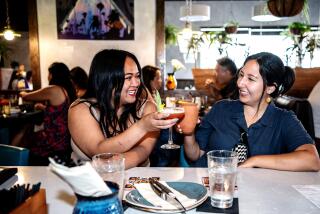Dear Mom, Please Send Food
- Share via
Want a guaranteed laugh? Mention good nutrition and college students in the same sentence.
“Oh sure,” says Martha Swanson, the mother of a 20-year-old Georgetown University student. “My son knows the rules of good nutrition: ‘Whenever there’s food, you eat it, no matter what it is--if someone else paid for it.’ ”
“I teach nutrition to college students,” says Baltimore dietitian Judith Knapp. “Their mouths always drop open when they find out what’s really in the food they eat.”
Health educator Carol Day of Georgetown University adds: “The typical college student skips breakfast, eats a light lunch and then crams a lot of calories into one meal at the end of the day, (including) late-night snacks.”
No wonder college administrators tell freshmen to expect to gain 10 pounds by the end of their first year. “And even that’s gone up,” says Norfolk dietitian Andrea Perkins. “It used to be called the Freshman 10. Now it’s the Freshman 15.”
“The perception--among college students themselves as well as everyone else--is that none of the students are eating well,” says Day, who is Georgetown’s director of health education.
When Day set up the university’s Center for Health Enhancement as part of the Office of Student Affairs six years ago, she says, “the most requested service was for nutrition counseling.”
She counsels about 160 students each semester about weight gain, eating problems (anorexia and bulimia) and sports nutrition, as well as more basic problems such as finding something decent to eat at the student cafeteria.
But the cafeteria isn’t the biggest problem. “Eighty percent of the student body is looking for something to eat that’s fast, but not necessarily good for them,” notes Knapp, who teaches nutrition at Essex Community College in Baltimore.
Knapp’s own college-age son told her he thought fast food must be good for him because it was cheap and filling.
“It’s a good thing that Chinese and Mexican food is popular,” she says. “They’re fast, but at least they use more vegetables and whole grains.”
Vegetables, in particular, are not popular among students. It’s the one item, Knapp says, that her students most consistently fail to eat. She urges them to try the cooked vegetables at the cafeteria or, failing that, to have a salad from the salad bar.
“Any dark, leafy greens are good. Just forget the iceberg lettuce--it’s all bulk and no vitamins.”
Allida Joyce of McLean, Va., who has sons at Notre Dame and Georgetown and a daughter who just graduated from the University of Southern California, believes that students are becoming more aware of what they eat.
Joyce, who works at Georgetown’s office of special services, says her son Matthew, a freshman at Georgetown, eats Lean Cuisine frozen entrees and makes homemade pizza with vegetables, cheese and prepared Italian bread crust in his dorm microwave.
She admits that he does skip breakfast and often ends up eating lunch at 3 p.m., “but his late-night snack is fruit, not junk food.”
Some students use college to broaden their culinary experience. Swanson reports that her 20-year-old son, Michael, discovered canned tuna in his second year at college.
“He asked me why I never told him about tuna. He told me, ‘Mom, it doesn’t take up a lot of space, it’s cheap and it’s good for me.’ I told him it had been in our house for years,” she says with a laugh.
Swanson says now that her son is on his own in an apartment, “he eats a lot of Domino’s pizza and take-out Chinese, but he’s also actually going to the grocery store and buying real food.” Chicken with rice is his favorite dinner, and tortellini gets made for company.
Still, her son is a typical college eater in other ways. He skips breakfast, doesn’t eat much lunch and saves most of his eating for dinner and late-night snacking--exactly the routine that Knapp warns her students against.
“You can’t eat once a day--that’s the blanket rule. You’re just beating up on your own body if you do,” Knapp says. She likens it to forcing your car either to run on fumes or overloading it with too much gasoline. “Most of the damage we do to our body comes when we overfeed it.”
She advises students to carry fruit, nuts or granola bars with them for snacking during the day. If they want to stop for a fast-food meal, she suggests Mexican fajitas or refried beans, or Chinese stir-fry with vegetables because the higher fiber content will keep them feeling full longer.
Although fast food is not an ideally nutritious meal, most dietitians realize it’s a student favorite and needs to be part of a practical eating plan.
In her counseling sessions, Day stresses to students that it’s OK to eat fast food, as long as it’s not eaten at every meal. “No one should have to give up anything they really love,” she says. She tells students that if they want fast food, they should at least try to avoid fried food.
“Don’t get the extra-crunchy fried chicken,” she tells them, “it’s just extra fat. Try the grilled chicken sandwich or have a roast beef sandwich instead of a burger.”
Knapp also realizes that ordering a midnight pizza or going out for a burger and fries is done as much for the socializing as for hunger. “I tell them that if they eat more vegetables and lower-fat meals during the day, then they’ll have more flexibility to do their social eating of pizza and burgers at night.”
More to Read
Sign up for Essential California
The most important California stories and recommendations in your inbox every morning.
You may occasionally receive promotional content from the Los Angeles Times.










